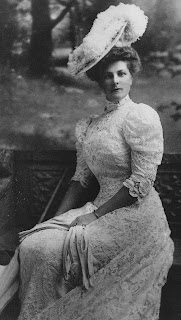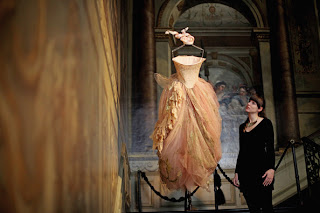The word lace evolved from the Latin laqueus, which means "noose" This textile appears to have developed in Europe and may have derived from the practice of fishermen mending their nets. The exact origins are obscure and many debate whether the resulting textile developed in the Netherlands or Italy. Certainly our earliest recorded and extant evidence of lace can only go back to the end of the 16th century. Interestingly, while embroidery appears in the textile heritage of many peoples, lace seems to be unique to Europe.
Drawnwork and cutwork seem to be the method of manufacture in these early examples with the practice of bobbin lace a close derivative of weaving. However it was produced, it could take years to manufacture one piece and cost the equivalent in todays dollars of many thousands. To control the industry and trade, it fell under sumptuary laws and was often smuggled to avoid strict laws and taxation. Their are many humorous accounts of smuggling attempts. Even corpses could be enlisted in the game to avoid customs officials. If found, the textile was burned. Imagine how much was lost to this practice. Certainly, to the owner, it was worth the risk for it was all about status.
Lace, prior to the 19th century was made from linen or silken threads and this is a good indication of age. At least a starting point. It is not always possible to rely solely on the patterns themselves as a clue to age, as they could be reproduced at any time. If the lace is made of wool or more commonly cotton, chances are that it is of 19th century manufacture. The exception would be, "blonde". It is made of silk and was very fashionable during the 2nd quarter of the 19th century.
 |
| Blond, last quarter 19th century |
The next step was to make patterned laces in an attempt to copy the more expensive and labour intensive styles of the lacemaker. Early nets were embroidered by hand in a darning stitch, known as needlerun, or chainstitch, known as tambour. A spotted net, Point d'Esprit appeared around 1831. By 1840, good imitations of many handmade laces began to influence fashionable dress. Valenciennes, Mechlin and Bucks. These early laces were often looked down upon by those who could afford antique examples of the hand made. Unfortunately, many of these were cut and remodeled to reflect current tastes and so many fine examples were lost or ruined. The 1880's saw the invention of chemical lace in Switzerland and Germany. A derivative of machine embroidery, the background material, which was usually of silk, was dissolved or corroded away by chlorine or caustic soda, leaving only the cotton stitching in tact. From a distance, patterns were similar to Reticella, Punto in Aria, Venetian Point, Irish crochet, Honiton or Brussels.
 |
| Point d'Esprit |
 |
| Edwardian dinner dress, author's collection |
The effects of the mechanization of lace manufacture were:
1. Handmade lace was no longer a status symbol, the machine made versions were difficult to differentiate from the real thing.
2. Lace trimming was used in greater profusion on dress and in home decor, and co-ordinated pieces, woven en disposition, were employed.
3. It was no longer possible for handmade lace to be produced economically. The industry would now have to rely heavily on royal patronage.
I began to collect examples of lace while teaching a course in Textiles. The examples shown are from that collection and I now will use them for my reproduction costumes.
Embroidered Laces:
Cutwork: Appeared as early as the 16th century: Cloth is cut with holes which are then embroidered around their edges. Most common example today would be referred to as, "eyelet". In the 19th century it was called, "Broderie Anglaise" and can be found in many undergarments, collars and cuffs of the period.
Madeira Work (above): Common to the turn of the last century. Seen most often in table linens.
Drawn and Pulled Threadwork: Here some of the threads are pulled or removed from the weave and the subsequent openings are bound over with stitching. Production in the 19th century moved from the Baltic area to England where it was known mainly as, "Ayrshire" work.
Filet or Buratto: One of the earliest lace techniques. The meshes are usually square and the motif is embroidered using a darning stitch. Variations in thread thicknesses could produce a shaded effect.
Needlepointed Laces: The basic unit to look for here is the buttonhole stitch, and so, if the lace looks as if it has been embroidered, it is probably a needlepoint lace. This technique produces some of the most beautiful examples and many machine copies were manufactured in the 19th century. Usually it is these laces that appear to embellish a Worth gown if the antique piece was not available.
Alencon: Originally of French manufacture. Extremely time consuming to produce. At the 1867 exhibition a dress was shown made from this lace that took 40 women 7 years to complete! Obviously, the mechanization of this lace made it very popular for mass consumption.
"Point de Colbert" (below): Mid 19th century copy of the heavier Venetian points. Characterized by the stiffness of the hand and large stitches. None the less, incredibly beautiful.
Bobbin Laces:
"Genoese" The example below, is quite different from its 17th century namesake. The central motif is the characteristic of the original that lends its name to this sample. Like Valenciennes, it was used extensively for lingerie trims and insertions.
 |
| Edwardian recreation by author |
 |
| Alan Suddon Collection |
 |
| Edwardian Lace dress, Metropolitan Museum |
 |
| Original owner in dress above |
 |
| 1920 Lingerie dress, authors collection |






























